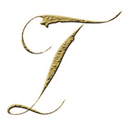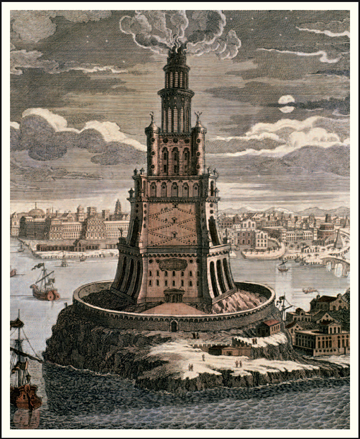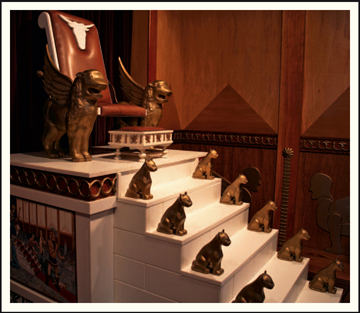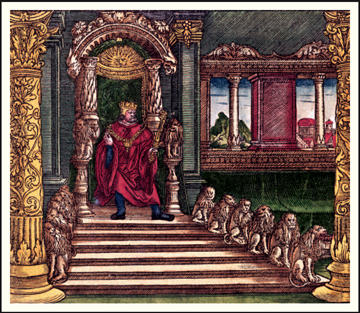
 HE GEORGE WASHINGTON Masonic Memorial stands atop Shuter’s Hill in Alexandria, Virginia. Built in three distinct tiers of increasing architectural complexity from bottom to top—Doric, Ionic, and Corinthian—the structure stands as a physical symbol of man’s intellectual ascent. Inspired by the ancient Pharos lighthouse of Alexandria, Egypt, this soaring tower is capped by an Egyptian pyramid with a flamelike finial.
HE GEORGE WASHINGTON Masonic Memorial stands atop Shuter’s Hill in Alexandria, Virginia. Built in three distinct tiers of increasing architectural complexity from bottom to top—Doric, Ionic, and Corinthian—the structure stands as a physical symbol of man’s intellectual ascent. Inspired by the ancient Pharos lighthouse of Alexandria, Egypt, this soaring tower is capped by an Egyptian pyramid with a flamelike finial.
Inside the spectacular marble foyer sits a massive bronze of George Washington in full Masonic regalia, along with the actual trowel he used to lay the cornerstone of the Capitol Building. Above the foyer, nine different levels bear names like the Grotto, the Crypt Room, and the Knights Templar Chapel. Among the treasures housed within these spaces are over twenty thousand volumes of Masonic writings, a dazzling replica of the Ark of the Covenant, and even a scale model of the throne room in King Solomon’s Temple.

GEORGE WASHINGTON MASONIC MEMORIAL, ALEXANDRIA, VIRGINIA
78.1: Philip Scalia/Alamy

ANCIENT PHAROS LIGHTHOUSE OF ALEXANDRIA, EGYPT
78.2: O’Shea Gallery, London, UK/The Bridgeman Art Library
CIA agent Simkins checked his watch as the modified UH-60 chopper skimmed in low over the Potomac. Six minutes until their train arrives. He exhaled and gazed out the window at the shining Masonic Memorial on the horizon. He had to admit, the brilliantly shining tower was as impressive as any building on the National Mall. Simkins had never been inside the memorial, and tonight would be no different. If all went according to plan, Robert Langdon and Katherine Solomon would never make it out of the subway station.
“Over there!” Simkins shouted to the pilot, pointing down at the King Street subway station across from the memorial. The pilot banked the helicopter and set it down on a grassy area at the foot of Shuter’s Hill.
Pedestrians looked up in surprise as Simkins and his team piled out, dashed across the street, and ran down into King Street Station. In the stairwell, several departing passengers leaped out of the way, plastering themselves to the walls as the phalanx of armed men in black thundered past them.
The King Street Station was larger than Simkins had anticipated, apparently serving several different lines—Blue, Yellow, and Amtrak. He raced over to the Metro map on the wall, found Freedom Plaza and the direct line to this location.
“Blue Line, southbound platform!” Simkins shouted. “Get down there and clear everyone out!” His team dashed off.
Simkins rushed over to the ticket booth, flashed his identification, and shouted to the woman inside. “The next train from Metro Center—what time is it due?!”
The woman inside looked frightened. “I’m not sure. Blue Line arrives every eleven minutes. There’s no set schedule.”

A REPLICA OF KING SOLOMON’S THRONE AT THE GEORGE WASHINGTON MASONIC MEMORIAL
78.3: William S. Kuta/Alamy

KING SOLOMON ON HIS THRONE, FROM THE LUTHER BIBLE
78.4: Bible Society, London, UK/The Bridgeman Art Library
“How long since the last train?”
“Five … six minutes, maybe? No more than that.”
Simkins did the math. Perfect. The next train had to be Langdon’s.
Inside a fast-moving subway car, Katherine Solomon shifted uncomfortably on the hard plastic seat. The bright fluorescent lights overhead hurt her eyes, and she fought the impulse to let her eyelids close, even for a second. Langdon sat beside her in the empty car, staring blankly down at the leather bag at his feet. His eyelids looked heavy, too, as if the rhythmic sway of the moving car were lulling him into a trance.
Katherine pictured the strange contents of Langdon’s bag. Why does the CIA want this pyramid? Bellamy had said that Sato might be pursuing the pyramid because she knew its true potential. But even if this pyramid somehow did reveal the hiding place of ancient secrets, Katherine found it hard to believe that its promise of primeval mystical wisdom would interest the CIA.
Then again, she reminded herself, the CIA had been caught several times running parapsychological or psi programs that bordered on ancient magic and mysticism. In 1995, the “Stargate/Scannate” scandal had exposed a classified CIA technology called remote viewing—a kind of telepathic mind travel that enabled a “viewer” to transport his mind’s eye to any location on earth and spy there, without being physically present. Of course, the technology was nothing new. Mystics called it astral projection, and yogis called it out-of-body experience. Unfortunately, horrified American taxpayers called it absurd, and the program had been scuttled. At least publicly.
Ironically, Katherine saw remarkable connections between the CIA’s failed programs and her own breakthroughs in Noetic Science.
Katherine felt eager to call the police and find out if they had discovered anything in Kalorama Heights, but she and Langdon were phoneless now, and making contact with the authorities would probably be a mistake anyway; there was no telling how far Sato’s reach extended.
Patience, Katherine. Within minutes, they would be in a safe hiding place, guests of a man who had assured them he could provide answers. Katherine hoped his answers, whatever they might be, would help her save her brother.
“Robert?” she whispered, glancing up at the subway map. “Next stop is ours.”
Langdon emerged slowly from his daydream. “Right, thanks.” As the train rumbled toward the station, he collected his daybag and gave Katherine an uncertain glance. “Let’s just hope our arrival is uneventful.”
By the time Turner Simkins dashed down to join his men, the subway platform had been entirely cleared, and his team was fanning out, taking up positions behind the support pillars that ran the length of the platform. A distant rumble echoed in the tunnel at the other end of the platform, and as it grew louder, Simkins felt the push of stale warm air billowing around him.
No escape, Mr. Langdon.
Simkins turned to the two agents he had told to join him on the platform. “Identification and weapons out. These trains are automated, but they all have a conductor who opens the doors. Find him.”
The train’s headlamp now appeared down the tunnel, and the sound of squealing brakes pierced the air. As the train burst into the station and began slowing down, Simkins and his two agents leaned out over the track, waving CIA identification badges and straining to make eye contact with the conductor before he could open the doors.
The train was closing fast. In the third car, Simkins finally saw the startled face of the conductor, who was apparently trying to figure out why three men in black were all waving identification badges at him. Simkins jogged toward the train, which was now nearing a full stop.
“CIA!” Simkins shouted, holding up his ID. “Do NOT open the doors!” As the train glided slowly past him, he went toward the conductor’s car, shouting in at him. “Do not open your doors! Do you understand?! Do NOT open your doors!”
The train came to a full stop, its wide-eyed conductor nodding repeatedly. “What’s wrong?!” the man demanded through his side window.
“Don’t let this train move,” Simkins said. “And don’t open the doors.”
“Okay.”
“Can you let us into the first car?”
The conductor nodded. Looking fearful, he stepped out of the train, closing the door behind him. He escorted Simkins and his men to the first car, where he manually opened the door.
“Lock it behind us,” Simkins said, pulling his weapon. Simkins and his men stepped quickly into the stark light of the first car. The conductor locked the door behind them.
The first car contained only four passengers—three teenage boys and an old woman—all of whom looked understandably startled to see three armed men entering. Simkins held up his ID. “Everything’s fine. Just stay seated.”
Simkins and his men now began their sweep, pushing toward the back of the sealed train one car at a time—“squeezing toothpaste,” as it was called during his training at the Farm. Very few passengers were on this train, and halfway to the back, the agents still had seen nobody even remotely resembling the description of Robert Langdon and Katherine Solomon. Nonetheless, Simkins remained confident. There was absolutely no place to hide on a subway car. No bathrooms, no storage, and no alternative exits. Even if the targets had seen them board the train and fled to the back, there was no way out. Prying open a door was almost impossible, and Simkins had men watching the platform and both sides of the train anyway.
Patience.
By the time Simkins reached the second-to-last car, however, he was feeling edgy. This penultimate car had only one passenger—a Chinese man. Simkins and his agents moved through, scanning for any place to hide. There was none.
“Last car,” Simkins said, raising his weapon as the threesome moved toward the threshold of the train’s final section. As they stepped into the last car, all three of them immediately stopped and stared.
What the … ?! Simkins raced to the rear of the deserted cabin, searching behind all the seats. He spun back to his men, blood boiling. “Where the hell did they go?!”